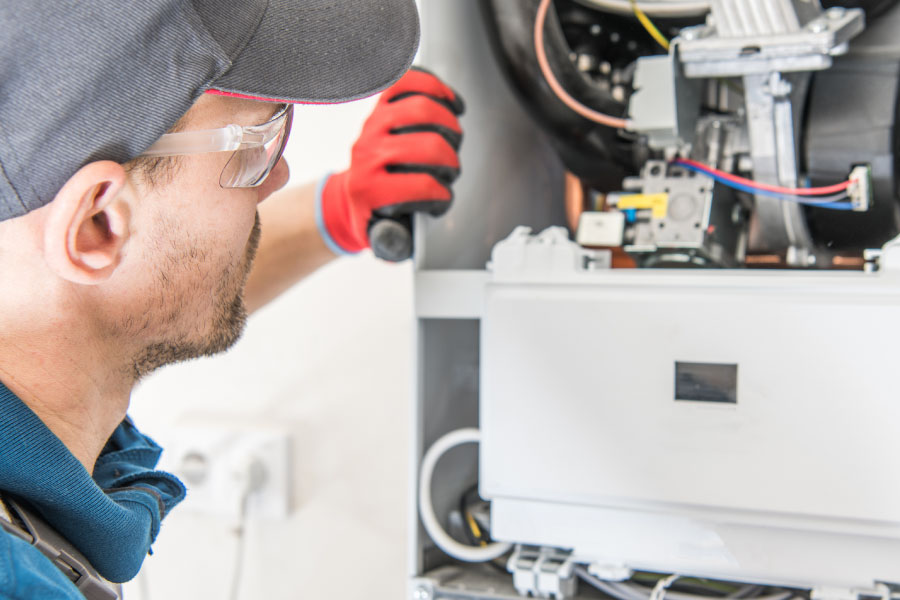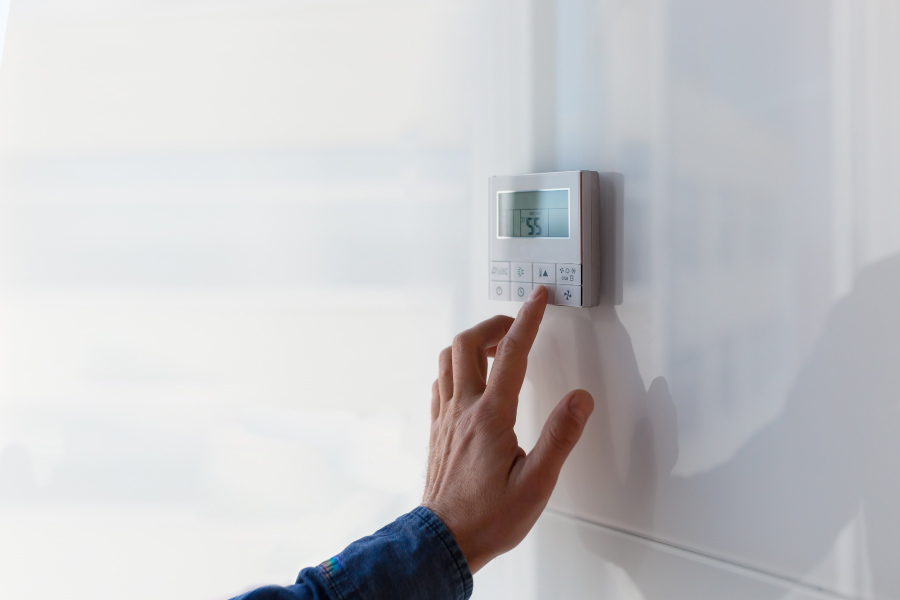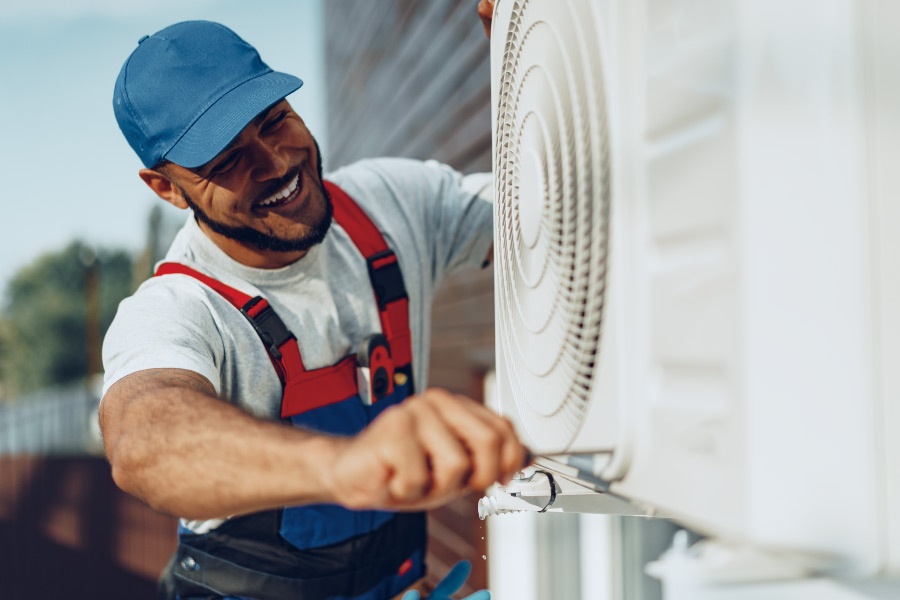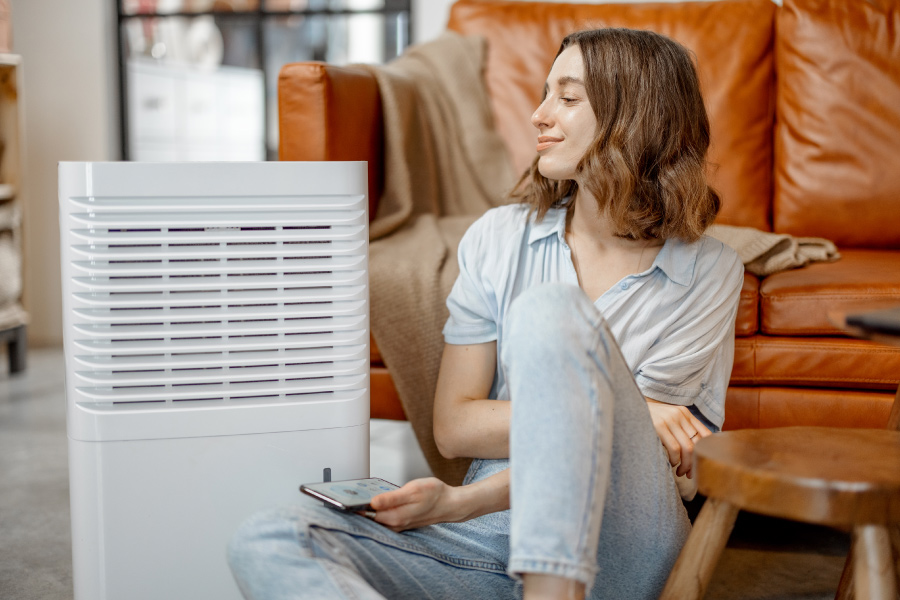
Heating and Cooling Solutions
Bozeman is growing, and with that growth comes new construction. From residential to commercial construction and remodels, every successful project depends on specialist expertise to deliver great results. HVAC installation is part of every build. However, not all HVAC contractors are the same.
Are you looking to hire a Bozeman HVAC contractor for your remodel or construction project? Our Mountain Heating & Cooling team has put together a list of essential questions to consider to help you confidently hire skilled, reliable, and professional Bozeman HVAC contractors (and avoid bad contractors that lead to additional time, money, or headaches).
5 Red Flags to Watch Out for When Hiring an HVAC Contractor
Red flag #1: They’re a one-person show
While a one-person company may claim the benefits of being nimble, flexible, and adaptable, the truth is one person has limited bandwidth compared to a team of technicians. It’s harder for a single contractor to be available should any issues come up at the last minute. And even if they’re brilliant and experienced, every project benefits from a variety of talent, experience, and diverse skill sets. The quality of an install is driven by the utilization—and understanding—of new, emerging technologies, so it’s hard for a single person to stay on top of the evolving market.
Green flag: They’re a dedicated team with the benefits of greater bandwidth, a customer service contact, and multiple areas of expertise.
Red flag #2: They’re not licensed, insured, or certified.
A solid, reputable HVAC contractor shouldn’t hesitate to provide you with proof of insurance and licensure. When it comes to HVAC service and other home maintenance, a lack of insurance can escalate issues like property damage and injury into major liabilities. If your HVAC contractor isn’t insured and licensed, they’re not guaranteed to know and follow building codes, which exist to protect you, your family, and your home.
While certifications aren’t necessary, they show continued education to gain broad and specific subject-matter expertise.
Green flag: A good HVAC contractor will be proud to highlight their certifications, and they’ll definitely provide proof of licensure and individual and business insurance coverage.
Red flag #3: They have bad reviews or no references.
Bozeman may be growing, but it’s still an interconnected community. Personal relationships are key. References establish personal and professional reliability and give you a picture of past work successes or hiccups.
Ideally, you’ll be working with a company with at least some online presence, such as a Google Business Profile, Facebook business page, or even Yelp or Houzz profile. Check out their online reviews. Note that all businesses, even the best ones, will receive a negative review once in a while. But too many low opinions add up to signal lingering issues.
Pay attention, in particular, to whether the same complaints come up in multiple reviews. Did the company respond to their negative reviews? What did they say? Don’t be shy to bring up negative reviews with the company directly. There are always two sides to the story, and a company with transparency about past mistakes or issues could be even more trustworthy and valuable to your project than one with a seemingly squeaky-clean online reputation.
Green flag: They offer easy-to-contact professional references, and you can find positive reviews of their company online.
Red flag #4: They have poor communication.
In our hyper-digital world, tradespeople may be some of the few who aren’t connected to the web 24/7. For example, when you’re elbow-deep in a complex furnace installation, you don’t want to be distracted by emails. If you choose your HVAC contractors well, they’ll have a dedicated team member who handles scheduling and communication, meaning someone will always be available to get a technician to your home. But if a company shows lengthy delays in their response times with no explanation or only offers vague explanations of quotes, pricing, or services, that may be your sign to look elsewhere.
Green flag: They communicate promptly, proactively, and professionally.
Red flag #5: They have an extremely low quoted bid.
Are you comparison shopping? Competitive bids are one thing, but outlier lowball cost estimates are a sure red flag. Remember: if it seems too good to be true, it usually is. A very low bid may only be possible through very low overhead—e.g., a company may not invest in quality equipment, dedicated staff power, or experienced HVAC technicians.
Green flag: Their bid is attractive but within the range of reasonable.
Contact Our Team for Reliable HVAC Contractors
The bottom line is that no matter the scope of your HVAC service needs, working with good Bozeman HVAC contractors pays dividends. At Mountain Heating & Cooling, we are proud to provide quality, trustworthy service at every step—from installation to communication. Please reach out to us to discuss your project needs!

Heating and Cooling Solutions
The seasons are changing in Montana and so is the way many folks heat their homes. Why? The recently passed Inflation Reduction Act has opened up to $2,000 in tax credit for new heat pump installs. Not only are heat pumps climate-friendly and capable of decreasing home energy costs, but as of January 1st, 2023, installing a heat pump makes homeowners eligible for thousands of dollars in tax credits and rebates.
You might be thinking, “tax credits sound great, but what is a heat pump?” Heat pumps are an all-in-one home heating and cooling system. Energy-efficient and cost-effective, heat pumps provide reliable, year-round heating and cooling, which can help lower your utility bills and carbon footprint. Because they don’t rely on fossil fuels, heat pumps are also more sustainable than traditional home heating systems like furnaces, boilers, or baseboard heat, as well as most air conditioners.
Thanks to the Inflation Reduction Act and recent advances in heat pump technologies, now is a great time to consider switching to a heat pump. Let’s dig into the details of heat pumps, this new legislation, and how you can benefit from it all!
What is a Heat Pump?
A heat pump is a heating and cooling system that redistributes heat from outside to inside (or inside to outside) using refrigerant, compression, expansion, and electricity to warm, cool, or maintain the temperature in your house. Heat pumps connect directly to your thermostat and regulate temperature by transferring heat in tandem with an air handler or furnace tied into ductwork or a fan coil mini split system.
There are a few kinds of heat pump systems available on the market, but the most popular models are called “split” heat pumps. This type of pump has two components—one outside the home, and one inside linked by pipes or ducts. Some split source heat pumps are “air-source”, meaning they transfer heat from the outside air. Others are ground-source, gathering and transferring heat from thermal energy in the ground.
How Does a Heat Pump Work?
Heat pumps work using simple principles of thermodynamics. Open your front door during a wintery day and you’ll feel warm air getting sucked outside; leave your door open too long on a hot summer day and your home’s cool air temp will rise as warmth from the outdoor heat moves in. Thermal energy—heat—moves naturally in one direction: from warm to cold.
A heat pump can also be thought of as a heat transporter. Heat pumps work by moving heat from where you don’t want or need it to where you do. In the summer, that might mean moving heat inside to outside your home. In the winter, the reverse is true.
Why Choose a Heat Pump over Other Heating Systems?
In the shoulder seasons, a heat pump will regulate your home’s air temperature warmer or colder, depending on your thermostat temperature settings, just like HVAC systems. However, instead of creating heat (like a gas combustion system) heat pumps simply transfer or redistribute existing heat. Rather than needing both an air conditioning unit and a furnace, choosing a heat pump means your home benefits from the simplicity (and cost savings) of an all-in-one system approach.
Many folks wonder if heat pumps are a good match for cold climates. In our opinion as trusted Bozeman HVAC contractors, the answer is yes! Heat pumps do not necessarily generate as many BTUs as traditional furnaces, but new cold-climate-specific models are highly reliable down to -20 degrees and 100% efficient below zero.
What Are the Advantages of Using a Heat Pump?
Heat pumps are very energy-efficient. In ideal conditions, heat pumps will transfer up to 300% more energy than they consume. In addition to heat, a heat pump can provide cooling benefits. An Air Source Heat Pump is essentially an air conditioner compressor that cools when in cooling mode or heats when there is a need for heat.
In contrast to a heat pump, a high-efficiency gas furnace would be around 95% efficient. Because heat pumps are powered by electricity, their fuel source is flexible —they don’t rely on fossil fuels to heat a home. They can also be sustainably powered by solar, geothermal, or hydroelectric energy, even tying directly into an off-grid home. In addition, heat pumps are safe, requiring no gas lines and producing no carbon monoxide.
How Much Will It Cost to Install My New Heating System?
Without accounting for tax credits and rebates, installing a heat pump, on average, may cost between $6,000 to $18,000. Trane heat pumps, trusted for their quality and reliability, are an excellent option for Montana homeowners looking to upgrade to a system that will last for decades. During the coldest months with an air source heat pump, there will need to be a supplemental heat source for outdoor temperatures between 20-30 degrees Fahrenheit and lower. Montana homeowners can count on approximately 80% of their year-long heat requirements coming from the heat pump’s air source heat and 15-20% coming from electric resistance heat, fireplaces, or gas-fired furnaces.
Once installed, a well-insulated home will see an average savings of 30% to 70% on energy costs. Because a heat pump is 2-3x more efficient than a gas furnace, the installation cost usually pays for itself in energy savings within 5-10 years.
What Are the Rebates I Can Receive for My New Heating System?
The Inflation Reducation Act included Heat Pump Provisions to help more homeowners afford energy-efficient heat pump systems through heat pump tax credits and rebates.
Through heat pump tax credits, the federal government is offering a dollar-for-dollar reduction in your owed income tax. This tax credit is good for 30% of the total cost of what you pay for a heat pump, up to $2,000 in total. This includes the system components and the cost of labor to install.
In addition to the tax credits, homeowners may be eligible for heat pump rebates good for up to $1,750 for a heat pump water heater and $8,000 for heat pumps for space heating and cooling.
All taxpayers qualify for the tax credit program, while eligibility for federal heat pump rebate programs depends on household income level.
- Households making less than 80% of their state’s median household income are eligible for 100% of the rebates.
- Households making between 80 and 150% of the median household income of their state are eligible for 50% of the rebates.
- If your household income is equal to or greater than 150% of the state’s median, you’re not eligible for the rebates, but you still qualify for the tax credits.
In addition to the tax credits and rebates specific to heat pumps, you can also claim up to $1,200 in total tax credits per year on costs related to upgrading the energy efficiency of your home. This may include air-sealing systems, upgrading your electrical supply, and doing a home energy audit.
Similar to the heat pump rebates, qualifying households can claim thousands of dollars in state-administered rebates on electrification and efficiency upgrades related to installing your heat pump. A tax preparer can help you navigate and claim all the tax credits and rebates available to help offset the cost of a heat pump.
Want to Learn More? Ask Your Montana Heat Pump Experts
When it comes to improving your home’s energy efficiency and reducing your energy bill year-round, choosing a heat pump could be an ideal solution for keeping your home warm, comfortable, and climate-friendly. The long-term benefits might be even more attractive in the coming months, thanks to the rebates for heat pumps that can offset the cost of purchase and installation.
Whether you need a Heating and Cooling contractor to your existing unit for winter temperatures, or you want to learn more about what a heat pump is, what models are available, and heat pump maintenance, we’re always available to answer any questions you might have. Contact our team today to schedule an appointment or ask your heat pump rebate questions.

Heating and Cooling Solutions
HVAC heating and cooling systems are complex but can run smoothly for many years without the need for replacement as long as they are regularly maintained and professionally serviced. Keeping your HVAC running smoothly is critical to maintaining a comfortable home temperature, but it’s also vital to protecting the quality of the air you breathe. When your HVAC unit runs as it should, your wallet will benefit too, with heating and cooling bills reflecting that energy-efficient functionality.
While smooth HVAC operation begins with proper system installation, you as a homeowner can help keep things in good working order. Check out our list of tips to keep your HVAC system running smoothly. If you have any questions, our team of experts at Mountain Heating and Cooling is always here to help—just drop us a line!
3 HVAC System Maintenance Tips for Homeowners
1. Change your filters regularly
Changing your HVAC filters is one of the easiest and most effective ways to keep your air clean and your HVAC heating and cooling running efficiently. Air filters are designed to clear out any allergens, smoke or dust particles, and other undesirable debris from the air circulating inside your home. When filters become clogged or dirty, the HVAC unit or air conditioner may have to work harder to move air. This wears down parts more quickly and can lead to easily-avoidable repairs.
Air filter replacement is simple and should be done every 30-90 days or whenever you notice the filters getting dirty. Filters need replacement more often during peak winter and summer months when your unit is working the hardest to regulate the indoor air temperature. Air filters may also need replacing more often during wildfire season when air quality is at its lowest. High-quality air filters last longer than cheaper ones and do a better job cleaning the air.
If you need a hand replacing your HVAC system’s air filters, schedule an appointment with our team of Bozeman heating and cooling specialists today.
2. Clear the area around your outdoor unit
Part of an HVAC heating and cooling system is an outdoor AC unit component. This outdoor component contains condenser coils, compressors, and a fan. Check your outdoor air conditioner unit to make sure the top, sides, and surrounding space around the unit are clear and free from leaves, twigs, plants, or other debris. You should also look for grass or weeds that might impact the unit’s operations and remove them immediately. By removing buildup that could disrupt air intake, the system will function better with less effort. This important preventative step helps your system run longer without having to service the air conditioner.
3. Clean the evaporator coil and condenser
Your air conditioner’s evaporator and condenser coils should be cleaned yearly as part of general maintenance. Regular cleanings help remove buildup and debris that can cause your system to run less efficiently and waste valuable air and energy. If you are not confident with removing and cleaning these parts of your air conditioner yourself (plus putting everything back together again), reach out to us to schedule an appointment. Cleaning these parts and others can be easily done as part of the seasonal service air conditioners need to run smoothly year-round.
While there are steps you, as a homeowner, can take to ensure your HVAC system runs smoothly, many times it takes an expert’s level of training and experience to ensure your home’s heating and cooling system is functioning as it should. As professionals, our Bozeman HVAC team has over 40 years of combined experience in the field of air conditioner maintenance, replacement, troubleshooting, and repair. Our services include but are not limited to the following:
- Inspecting the filters, fan, motor, blower, and all other components of an air conditioner to ensure they are in excellent working order.
- Checking the vents, air ducts, drain line, evaporator coil, and condenser for potential issues.
- Testing the operational temperature of your HVAC heating and cooling units.
- Checking the liquid levels of coolants and refrigerants.
Regular, professional maintenance is essential for a comfortable home temperature and clean air. It can help avoid the need for air conditioner replacement, which is often timely and costly if you aren’t prepared.
Is My HVAC Heating and Cooling System Malfunctioning? Common Signs to Look for.
A struggling system might be most noticeable during a hot, smoky summer or frigid winter, but it’s best to keep an eye on your HVAC year-round.
System malfunctions might show up in the following symptoms:
- A sudden spike in your energy bill.
- Vents that barely blow air.
- An air conditioning unit that blows hot air instead of cold, or a furnace that blows cold instead of hot.
- Loud or unusual noises coming from the AC or HVAC.
- Ice on the compressor.
If your system shows any of the above signs, it might need professional attention. Our highly-trained professionals only deliver the best of the best work and provide insight you can trust, keeping your home air at a pleasant temperature no matter what the outside weather is doing. We’re able to quickly diagnose and repair problems to keep your HVAC serviced and running smoothly for years to come.
Need a Bozeman HVAC Expert’s Opinion? We’re Here to Help
We treat your home like our own, in that we go above and beyond to ensure every component of your HVAC system is running smoothly, safely, and efficiently. We value your and your loved one’s comfort, so we take the time to understand your home’s HVAC system to provide educated recommendations, quality services, and top-notch customer service. If your HVAC system needs some TLC or a regular checkup, schedule an appointment with Mountain Heating and Cooling today.

Heating and Cooling Solutions, Service
You’ve just purchased your first home in Bozeman—congratulations! Whether you’re building from the ground up or remodeling to make it the house of your dreams, you’ll need to consider air conditioning installation at some point. Air conditioning is no longer considered a luxury as it was several decades ago. To stay cool on the hottest Montana days, you’ll need an air conditioning unit tailored to your home’s specific cooling needs and designed for durability. In this quick guide, we’ll outline what’s involved with a basic A/C unit installation, costs, and what you should consider before hiring a technician to install an air conditioner.
It’s crucial to note that this is not a DIY guide. Air conditioning installation should always be done by a licensed professional. Our goal is to give you a brief overview of what to expect with a Bozeman air conditioning installation so you can make informed decisions about your HVAC system. We believe in arming our customers with the best information possible so they feel confident in their home care choices.
Quick Guide to Bozeman Air Conditioning Installation
What’s Involved in Air Conditioning Installation
The process of air conditioning installation can be broken down into four stages: the initial visit, the check-in with the installation team, the actual system installation, and the final cleanup and walk-through.
Initial Visit
During the initial visit, a Home Comfort Adviser will review your existing air conditioning system. Or, if you are currently in the building stage, they will go over what type of A/C unit would best suit the needs of the home’s floor plan. They will collect necessary information about your home and personal cooling needs to provide the most accurate estimate possible. The in-home assessment we provide includes a heat gain/loss calculation based on your specific home, measurements of the existing system, and a compatibility check on what types of equipment can be used to serve you. After the visit, you will be provided with estimates for one or more options to choose from. Once you agree on the estimate and installation proposal, you will schedule a time for an installation team to set up the new air conditioner in your home.
Installation Team Check-In
When the installation team arrives to install your air conditioning unit, they will share and review the job information with you. This way, you can see the full details of the job including equipment information and any special instructions given by you to the estimator. After taking a few moments to review the job information and sign off on the process, the installation team will start laying down drop cloths and other protective equipment to keep your home safe and clean. They will also turn off the gas supply and electrical circuits connected to the existing HVAC system.
System Installation
Air conditioning installation is a very involved process, so only trained professionals should install an A/C unit. For an air conditioning replacement, your installation team will remove the existing air conditioner (if applicable), safely reclaim and recycle any refrigerant, and prepare the area for the new air conditioner unit. Preparing the area may include leveling the ground and replacing the pad the unit will be set on. Then, the new unit is installed, which includes installing new indoor evaporator coils, placing new copper refrigerant lines, setting up the new air conditioner condenser, etc. On average, air conditioner system installation takes about eight hours in total.
Final Cleanup/Walk-through
After installation is complete, the team will remove any old equipment, clean up the work area, restore power and gas to the unit, and ensure your home is spotless after they leave. As a TRANE and Mitsubishi Dealer, we do a factor “Start Up” of your new equipment to validate the proper operation, refrigerant levels, and expected performance, which includes testing and adjusting fan speeds and refrigerant levels if instructed. Your installers will also walk you through the work completed and go over any special instructions, safety, maintenance, etc. After this, signatures and payments are collected.
Air Conditioning Installation Costs
The total price of air conditioning installation varies depending on the project. On average, installing a new air conditioner will cost roughly between $5,000 and $15,000. A variety of factors go into the price of an installation project but typically include the following:
- New vs Replacement – An entirely new air conditioning system requiring ductwork will typically cost more than only replacing the air conditioning unit.
- Comfort Level – Everyone has different levels of desired cooling comfort for their home. Whether you rarely turn on the A/C or love the constant cool, your ideal comfort level will contribute to the type of air conditioner unit you choose and how many rooms you need cool air to flow to.
- Home Efficiency – If your home is efficiently designed, it may already do a great job naturally staying cool in the hotter months. However, if you have poor insulation and lots of natural light, you may need a more robust air conditioner to keep your home cool.
- Desired Efficiency – Air conditioners with high energy efficiency typically cost more upfront, but they can save you more money on your utility bills in the long run.
- Noise Level – Different A/C unit models have different levels of noise they put out, so you will want to choose a system that fits your desired level of quiet.
- Choice of System – Depending on your system of choice, a central A/C unit may cost between $5,000 and $13,000. The system you choose depends on your budget and home’s needs.
- Square Footage – Your home’s size will determine the size of the air conditioning unit you need for it. Larger homes need more powerful systems to cool the entire home. An HVAC professional can help you determine which size of air conditioning unit best fits your home’s size by providing an ACCA-approved load calculation.
- Consideration of Heating – An alternative to a standard air conditioner is a heat pump. With a heat pump, you can heat and cool your home. As you plan for efficiency and reducing your carbon footprint, a heat pump can help improve your home’s comfort and efficiency.
- Labor – The amount of work involved in installing your new system contributes to the specific price of your project.
Yea Top-Notch Bozeman AC Installation
To see what your air conditioning installation options are, reach out to our team of Bozeman HVAC professionals. At Mountain Heating & Cooling, our technicians are well-versed in A/C installation. Each technician goes through rigorous training before stepping foot into your home. We understand that air conditioning is a significant investment in your home’s value, so we go above and beyond to make sure you are well informed on what your options are so you can make educated, confident choices. To get an estimate, schedule an appointment with our team today.

Heating and Cooling Solutions
Summer in Bozeman, MT often means cranking up your A/C to escape the outdoor heat. However, that extra use of your air conditioner can often cause your monthly utility bill to skyrocket. You should never have to choose between enjoying the indoors and saving money on air conditioning. At Mountain Heating & Cooling, we are here to make every aspect of your home comfortable, including your summer energy expenses. To help you stay cool and save money on air conditioning during the summer, we’ve listed our top recommendations for how to take extra work off your air conditioner. Soon, you’ll be kicking back in your cool home and not thinking about bills or the heat!
6 Ways to Save Money on Air Conditioning
1. Check Your Windows and Blinds
To save money on air conditioning, let’s start with your windows. According to the U.S. Department of Energy, heat gain and loss through windows are responsible for 25%-30% of heating and cooling energy use in residential homes. Older windows can cause your home to absorb more heat than newer models. If your existing windows are not in good working condition or are outdated, replace your existing windows to improve efficiency. You can even tint your windows for extra help in blocking sunlight. While there is an upfront cost involved, in the long run, you’ll make up for it with lower utility bills.
Poorly sealed windows can also be the culprit of higher utility bills. Windows without proper sealing let excess hot air in your home and let the cool air out, making your A/C unit work overtime. Caulking the leaks or cracks and weather-stripping your windows can help trap cool air in your home.
Installing blinds or curtains over your windows can also help block out excess sunlight so you do not need to run your air conditioner as frequently. In fact, Christina Kielich, spokesperson for the U.S. Department of Energy, says “When completely closed and lowered on a sunny window, highly reflective blinds can reduce heat gain by around 45%.” To start, try using light-colored window treatments. Lighter hues tend to deflect the sun’s rays more than darker colors. Hang the shades as close to the window as possible to block outdoor heat from radiating inside.
2. Update Your Thermostat Habits
Your thermostat is one of the best places to start optimizing your home’s HVAC system for the summer. Firstly, it’s crucial to not leave your A/C on full blast all the time. Instead of turning off your A/C completely, it is best to set your temperature within 4 degrees Fahrenheit of where you want it when you are out of the house. When your home’s ambient temperature increases on a hot day, all of your home’s surfaces collect heat. These surfaces need to be cooled and rooms dehumidified as part of the cooling process. It is very difficult to cool a hyper-heated home. If your home is at a reasonable temperature when you’re away, you’ll get enormous savings and quicker recovery of cooler temperatures when you return. Contrary to “what Mom and Dad told you”, a constantly running air conditioner will cost less to operate.
Installing a smart thermostat can help you better regulate your air conditioning and save money at the same time. Smart thermostats allow you to program the thermostat to the desired temperature and automatically adjust when you are out of the house or at set times of your choice.
3. Get Your Cooling System Serviced
Scheduling regular air conditioner maintenance is one of the biggest ways to save money on air conditioning. A/C units that are clogged with dirt and debris make your HVAC system work harder than it needs to. This excess use of energy not only skyrockets your utility bill but it puts extra strain on your air conditioner. This can lead to early repairs or even A/C failure. We recommend the following:
- Regularly clean and replace your air filter every few months.
- Tidy the area around your air conditioning unit.
- Have a technician clean out your HVAC system before and after the summer.
- Remove or trim overgrown plants around your outdoor condenser.
4. Use Fans Whenever Possible
Fans are an excellent way to keep cool during the summer months in Montana. Fans can make the indoor temperature feel six to seven degrees cooler in a room, whether you use a ceiling fan or other type of circulating fan. Just remember to turn off the fan when no one is enjoying it. Otherwise, you will waste excess electricity.
5. Reduce In-Home Activities that Produce Heat
Did you know that microwaving or, better yet, barbequing your food instead of cooking it on your stovetop can help you save money on air conditioning? Activities that generate a lot of heat in your home can cause excess heat to build up, making your air conditioner work harder and longer. From cooking on the stovetop to running the dishwasher to using the clothes dryer, try to save these activities until after dark when temperatures have dropped.
6. Invest in an Energy-Efficient Air Conditioner
It’s important to look past your summer utility expenses and consider long-term energy savings. In the long run, a new energy-efficient air conditioner could save you more money than making do with an energy-guzzling A/C unit. While a new air conditioner may cost more money up-front, newer units are more energy-efficient, which can make them less expensive to operate over the years. As an alternative to a straight air conditioner, an air source heat pump can serve as your air conditioner during the summer and primary heating resource during shoulder seasons and winter—just ask us how!
When choosing an air conditioner, double-check that the unit is ENERGY STAR certified and that it has a SEER rating that carries the added benefit of a Montana State Energy Credit. An air conditioner with an ENERGY STAR stamp of approval means it meets the Environmental Protection Agency’s (EPA) standards for using less energy. The higher the ENERGY STAR rating, the more energy-efficient the air conditioner is. SEER rating (Seasonal Energy Efficiency Ration) is the air conditioner’s cooling output divided by the total energy used in a cooling session. Like ENERGY STAR ratings, the higher the SEER rating, the better the energy efficiency. The top air conditioner brands we recommend for energy efficiency are Trane and Mitsubishi Ductless.
If you need a hand selecting an energy-efficient air conditioner for your home or business, we’re here to help and would love to talk to you. Our team can provide a complimentary in-home comfort assessment and specifications of the different units and make our recommendations for which model fits your home best. A new air conditioner installation is a major decision, so we want to provide all the information you need so you feel confident in your choice.
Need a Hand Getting Your Home Summer-Ready?
Whether you need repairs or would like a hand selecting the right Trane air conditioner for your home, reach out to our team for tips on how to save money on air conditioning. Our Bozeman air conditioning specialists take special care to ensure your home is safe, energy-efficient, and comfortable during every season. From replacements to general maintenance, our technicians cover every HVAC need with the utmost professionalism and respect. Fill out our contact form to schedule an appointment, or give us a call at (406) 586-4007.

Heating and Cooling Solutions
Keep Your Air Safe & Clean During WildFire Season
Wildfire smoke is a danger, even if the fire is hundreds, maybe thousands, of miles away from Bozeman, MT. Air quality diminishes during wildfire season. To protect yourself and your home, it’s crucial for your home to have an air filter for wildfire smoke. A simple filter swap or installation can be the difference between facing negative health impacts and enjoying a safe and clean home. Let’s review the facts about wildfire smoke and why it’s important for your home to have air filters for forest fire smoke.
The Importance of a Wildfire Particulate-Free Home
In Montana, forest fires are becoming an increasingly frequent problem, with causes including drought, climate change, and fuel buildup in unburned forests. Forest fire smoke contains a mix of gasses and fine particles from burned wood and other organic materials. The lightweight nature of wildfire particulates means it can be swept into the jetstream and spread for thousands of miles. Fires on the west coast have the potential to decrease air quality on the other side of the continent.
These fine particles caused by wildfire smoke pose a significant threat to our health, especially our lungs. Impacts of inhaling wildfire smoke include coughing, phlegm, wheezing, and difficulty breathing. People often experience a range of both physical and mental symptoms, from headaches to fatigue and irritability [1]. Long-term exposure has been linked to respiratory infections, asthma, and an increased risk of death [2]. While some people experience a higher risk of smoke-related health impacts, everyone should be prepared to decrease their wildfire smoke exposure.
Tips for Improving Indoor Air with an Air Filter for Wildfire Smoke
For Bozeman homeowners with an HVAC system, there are easy steps to take that can improve the air quality during the smokey season. In fact, your home’s central air system is one of the simplest, most effective, and most affordable ways to filter indoor air.
Shut Off Outdoor Air Intake
In most home HVAC systems, the air filter is located before the blower motor, between the furnace’s heating aspect and an air duct. Typically, a heating and cooling system can shut off outdoor air intake and recirculate (and filter) indoor air. During wildfire season, this keeps smoke out while continuously filtering indoor air. If you’re unsure how to shut off the outdoor air intake, our team can send a technician to show you the filtration capabilities of your home’s HVAC system. They can also help adjust it to ensure your indoor air quality remains high.
Upgrade to a High-Efficiency MERV Air Filter
Improving the air quality in a home is often as simple as upgrading your indoor air filter. Some home air systems use low-efficiency air filters with a Minimum Efficiency Reporting Value (MERV) rating of 1–4. A medium efficiency filter (MERV 5–8) is sufficient for common indoor pollutants like pet hair and dust bunnies. But come wildfire season, we highly recommend using air filters with a MERV rating of 13-16, a true high-efficiency filter. Filters with a MERV value of 13 or above can remove up to 95% of all wildfire smoke particulates. While most home HVAC systems will accommodate a MERV filter of 13 or above without issue, some older systems may need a different model or a slight system modification.
Regularly Replace Your Air Filter
Regularly replacing your high-efficiency filter will help your HVAC system run better and improve your air. Smoky outdoor air conditions clog a filter faster than usual. To keep your air clean and reduce strain on the system during the high-use season, we recommend replacement around every three months. Our professionals can determine the right air filter, setup, and replacement frequency for your home.
Secure the Rest of Your Home
In addition to replacing and maintaining your HVAC air filters, there are other simple steps to take for a clean, safe home:
- Close doors, windows, vents, and dampers to reduce outdoor airflow.
- Don’t use bathroom fans when possible, as they can draw in the unfiltered, smoky air.
- Consider buying a plug-in air purification system if your system can not take a MERV 13+ rated filter.
- Clean your surfaces regularly with a wet cloth and damp mop.
Understanding the Air Quality Index (AQI)
The Air Quality Index (AQI) is a color-coded index used to report and forecast daily air quality. The Index measures the most common ambient air pollutants, including wildfire smoke. The higher the AQI, the more important it is to reduce exposure.
The AQI is typically low for most of the year in Montana, where we are less affected by urban pollution. Come wildfire season, it’s not unusual to see days and even weeks on end with the AQI between 101 to 200. This corresponds to “Unhealthy for Sensitive Groups” and “Unhealthy.” It’s important to be ready for the smoky season in advance by preparing your HVAC system with a high-quality air filter for wildfire smoke.
We Keep Your Indoor Air Safe
No matter what HVAC setup you currently have, Mountain Cooling & Heating can make the most of your system for a cleaner, healthier home. By choosing the best air filter for wildfire smoke, replacing filters regularly, and keeping your home closed off from outdoor particulate matter, you’ll be happy and healthy this wildfire season. To prepare your home for wildfire season, schedule an appointment with our team today. Our Bozeman-based HVAC experts can provide the necessary installations and recommendations to protect your home.






